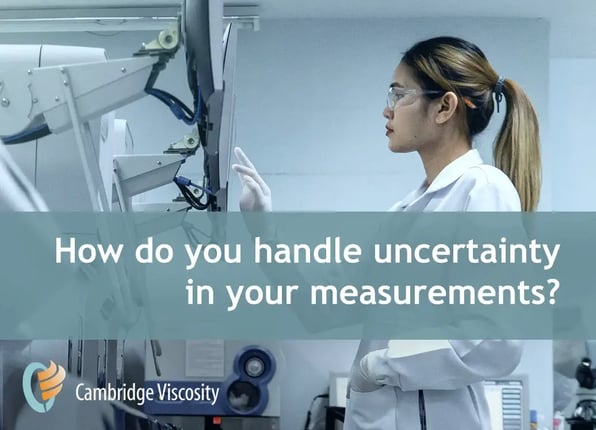 There is always some level of uncertainty in comparing on-line viscosity measurements with laboratory measurements. When it comes to viscosity analysis, a major reason for that uncertainty – and inconsistent measurements – is because the fluids are, in fact, under different conditions.
There is always some level of uncertainty in comparing on-line viscosity measurements with laboratory measurements. When it comes to viscosity analysis, a major reason for that uncertainty – and inconsistent measurements – is because the fluids are, in fact, under different conditions.
Viscosity is the resistance experienced by one layer of a liquid in moving over another layer. The level of viscosity of a liquid is largely dependent on the size, shape, and chemical makeup of their molecules. However, several characteristics can also affect in-line and in-fluid measurements. In-line instrument and lab instruments obtain different results because the fluid being measured can be impacted by shear, flow conditions, exposure to air, changes in temperature, changes in measurement conditions, and sample timing. These characteristics actually change the fluid, so what is being analyzed in the lab is actually different from the fluid in the process.
| Characteristic | In-Line | In Lab |
| Shear | Uncontrolled Shear from pumps and pipe bends | Controlled shear |
| Flow conditions | Varying | Fluid is static in a vessel |
| Closed/Open System | Processes are frequently closed systems after the addition of the basic ingredients, water/solvents, surfactants, etc. | Fluid is exposed to air which changes its composition through off-gassing or other interactions |
| Temperature | Frequently process temperatures are elevated, and often fluctuating. | Measurement is made at a different temperature than the process is running, and it is usually constant. |
| Measurement | Measurement conditions are often consistent (experiencing the same levels of fluctuations in the process, measurement to measurement) | Measurement conditions may vary from lab technician, especially with cups and capillary tubes. Calibration may not be recent |
| Timing of Sample | In a flowing line it is often difficult to be sure that sample passing over the sensor is exactly the same as sample drawn from a sample port. Any difference may cause the in-line measurement to differ from the sample taken to the lab |
Sample can be tested and retested |
Calibrating a Cambridge Viscometer
To ensure viscometer readings are accurate, it is necessary to calibrate the instrument in the factory, and periodically over the course of a viscometer’s lifecycle. Viscometer calibration is done using calibration fluids to ensure instrument accurate and alignment with industry standards. The calibration fluids Cambridge uses have known characteristics that are documented and tied to traceable standards. All Cambridge instruments are factory-calibrated with these traceable standards, and the calibration is certified. We note the particular fluids used, their traceability and the results of the calibration. In all cases the factory calibration sheets supplied with each instrument shows the instrument maintains its specified accuracy (1% of the full scale value for the VISCOpro 2100, for instance).
Calibration fluids can be used to evaluate process measurements. Specifically, by removing the process instrument from the line and testing it with calibration fluid, it can be compared to the result from a lab instrument using the same fluid. In such a test, both instruments should yield the same result.
Unfortunately, process fluids are typically not calibration fluids and are affected by the characteristics of the process itself.
In order to maintain consistency with historical data, we are sometimes asked if the in-line value could be calibrated to match the lab values adjusting for all of the process and temperature differences. By using the ASTM temperature compensation techniques incorporated in many of our viscometers, the effects of temperature fluctuations and differences can be mitigated.
The Relationship Between Viscosity and Temperature
The viscosity of most fluids decreases as its temperature increases and vice versa. This occurs because as the liquid is heated, the force of attraction between the molecules, the cohesive forces, is reduced. This principle is very important to understanding differences between laboratory viscosity measurements and process viscosity measurements when they are performed at different temperature. We use temperature compensated viscosity (TCV) to compensate for the varying temperatures of lab and process fluids. TCV is a highly accurate estimate of the viscosity of a fluid at a reference temperature that is different from the actual process temperature. The mathematical relationship is based on the ASTM standard D341 and is accurate for liquid hydrocarbons and most other fluids. TCV is used to relate process measurements to laboratory standard values and to mitigate the effects of process temperature fluctuations for tighter viscosity control.
A lubricant’s viscosity-temperature relationship is characterized by its viscosity index. VI is a measure of how much lubricating oil viscosity changes with temperature. The viscosity of lubricating oil with a high VI number will be less affected by changes in temperature while the viscosity of lube oil with a low VI number will be greatly affected by changes in temperature. The viscosity index is calculated by measuring the viscosity of the oil at two different temperatures (40°C and 100°C). Many labs utilize CVI’s VISCOlab 3000 with its integrated temperature controller for this calculation, but many refineries will use two VISCOpro 2100 systems installed in the production line with a heat exchanger in between the instruments to calculate the VI in real time.
If you have questions about the consistency of your lab and process measurements, reach out to our application specialists to discuss your challenges.





